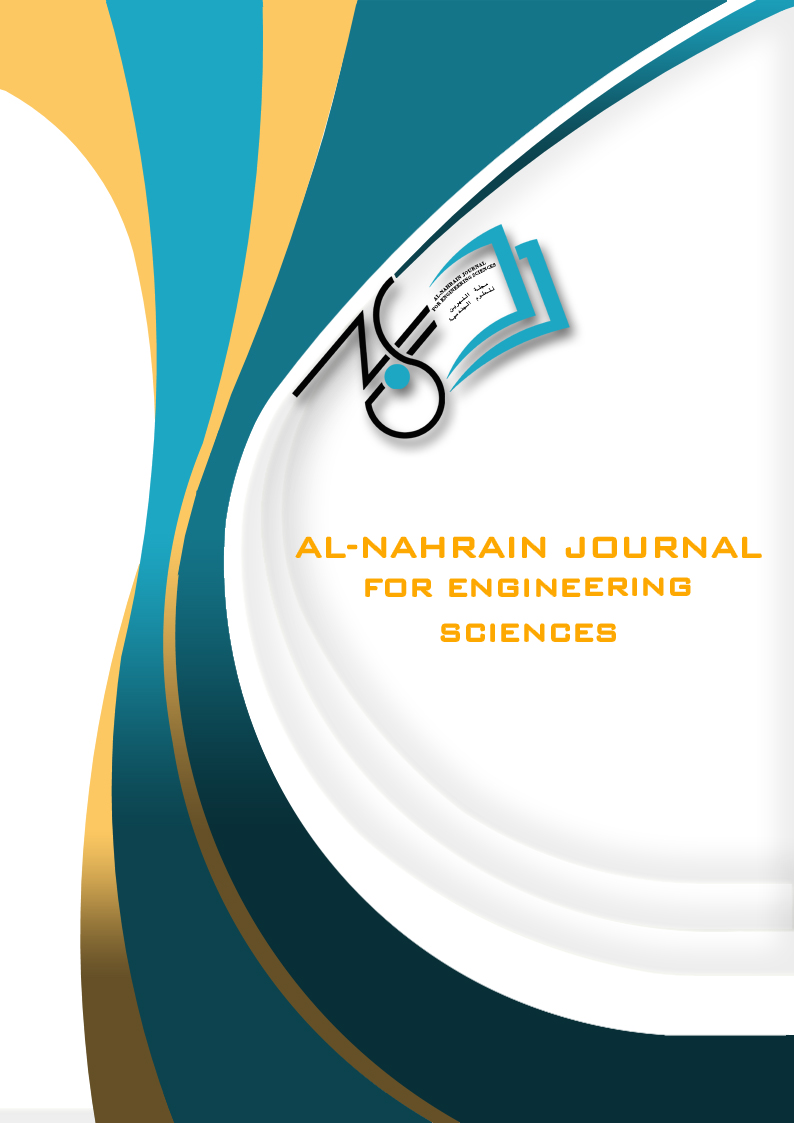The Seismic Response of a Shallow Foundation Supported on Geogrid-Reinforced Sand Soil
DOI:
https://doi.org/10.29194/NJES.28030481Keywords:
Geogrid Reinforcement, Foundation Rotation, Horizontal Displacement, Liquefaction, Sand Soil, Settlement, Shaking Table, Turkey EarthquakeAbstract
Shallow foundation suffers from considerable settlement, displacement and tilting under earthquakes. This is particularly due to the shaking associated with earthquakes that lead to the generation of horizontal seismic load transferred through the soil to the foundation. Also, liquefaction could take place during the earthquake in the saturated loose sand. To alleviate the detrimental effect of earthquakes, ground improvement is required. This study examines the response of the shallow square foundation rested on loose sand soil reinforced with geogrid reinforcement when subjected to 2023 Turkey earthquake by using a shaking table system. Different number of geogrid layers are installed; (one, two, three and four), also various geogrid configurations were examined which are (straight, trapezoidal and reverse trapezoidal). The acceleration response, settlement, horizontal displacement, rotation and pore water pressure developed in the sand soil and the shallow foundation during 2023 Turkey earthquake has been examined. The settlement and the horizontal displacement, foundation rotation, acceleration and pore water pressure were measured using rope displacement transducers, tilt sensors, accelerometers and pore water transducers respectively. The results showed that the acceleration amplifies when passing through loose sand. The results also indicated that the shallow foundation experienced noticeable settlement, horizontal displacement and rotation when subjected to the seismic loads. On the other hand, the installation of geogrid proved to be effective in controlling the problems associated with earthquakes. The optimum geogrid reinforcement is occurred when three layers of geogrid placed in reverse trapezoidal configuration (3RT) since it gave the best reduction in the acceleration amplification and the highest decrease in the foundation settlement, displacement and tilting which is about (60-66) %. Nevertheless, the effectiveness of geogrid minimizes when the sand soil becomes saturated. In addition, liquefaction occurs during earthquakes especially at the shallower depths because of the decrease in the shear strength of saturated soil.
Downloads
References
V. K. Puri and S. Prakash, "Shallow foundations for seismic loads: Design considerations," in Proc. 7th Int. Conf. Case Histories Geotech. Eng., Chicago, IL, May 3, 2013. https://scholarsmine.mst.edu/icchge/7icchge/session14/6
J.-Q. Wang, et al., "Influence of reinforcement-arrangements on dynamic response of geogrid-reinforced foundation under repeated loading," Constr. Build. Mater., vol. 274, p. 122093, 2021. DOI:10.1016/j.conbuildmat.2020.122093 DOI: https://doi.org/10.1016/j.conbuildmat.2020.122093
M. Ziegler, "Application of geogrid reinforced constructions: History, recent and future developments," Procedia Eng., vol. 172, pp. 42-51, 2017. DOI:10.1016/j.proeng.2017.02.008 DOI: https://doi.org/10.1016/j.proeng.2017.02.015
Z. Zhang, et al., "Influence of number of geosynthetic layers on the performance of geosynthetic-reinforced pile-supported earth platforms on soft soil: Numerical study," in Proc. Int. Conf. Transp. Infrastruct. Mater., Qingdao, China, 2017. DOI:10.12783/dtmse/ictim2017/10045 DOI: https://doi.org/10.12783/dtmse/ictim2017/10045
A. Morsy, et al., "A new generation of soil-geosynthetic interaction experimentation," Geotext. Geomembr., vol. 47, no. 4, pp. 459-476, 2019. DOI:10.1016/j.geotexmem.2019.04.002 DOI: https://doi.org/10.1016/j.geotexmem.2019.04.001
A. M. Morsy and J. G. Zornberg, "Soil-reinforcement interaction: Stress regime evolution in geosynthetic-reinforced soils," Geotext. Geomembr., vol. 49, no. 1, pp. 323-342, 2021. DOI:10.1016/j.geotexmem.2020.10.004 DOI: https://doi.org/10.1016/j.geotexmem.2020.08.007
R. J. Bathurst and F. M. Naftchali, "Geosynthetic reinforcement stiffness for analytical and numerical modelling of reinforced soil structures," Geotext. Geomembr., vol. 49, no. 4, pp. 921-940, 2021. DOI:10.1016/j.geotexmem.2021.01.003 DOI: https://doi.org/10.1016/j.geotexmem.2021.01.003
A. C. Pires and E. M. Palmeira, "The influence of geosynthetic reinforcement on the mechanical behaviour of soil-pipe systems," Geotext. Geomembr., vol. 49, no. 5, pp. 1117-1128, 2021. DOI:10.1016/j.geotexmem.2021.07.005 DOI: https://doi.org/10.1016/j.geotexmem.2021.03.006
B. K. Maheshwari, H. Singh, and S. Saran, "Effects of reinforcement on liquefaction resistance of Solani sand," J. Geotech. Geoenviron. Eng., vol. 138, no. 7, pp. 831-840, 2012. DOI:10.1061/(ASCE)GT.1943-5606.0000646 DOI: https://doi.org/10.1061/(ASCE)GT.1943-5606.0000645
J. Dhanya, A. Boominathan, and S. Banerjee, "Response of low-rise building with geotechnical seismic isolation system," Soil Dyn. Earthq. Eng., vol. 136, p. 106187, 2020. DOI:10.1016/j.soildyn.2020.106187 DOI: https://doi.org/10.1016/j.soildyn.2020.106187
R. Xu and B. Fatahi, "Influence of geotextile arrangement on seismic performance of mid-rise buildings subjected to MCE shaking," Geotext. Geomembr., vol. 46, no. 4, pp. 511-528, 2018. DOI:10.1016/j.geotexmem.2018.03.007 DOI: https://doi.org/10.1016/j.geotexmem.2018.04.004
H. Bahadori, et al., "Shaking table tests on shallow foundations over geocomposite and geogrid-reinforced liquefiable soils," Soil Dyn. Earthq. Eng., vol. 128, p. 105896, 2020. DOI:10.1016/j.soildyn.2019.105896 DOI: https://doi.org/10.1016/j.soildyn.2019.105896
N. Srilatha, G. M. Latha, and C. Puttappa, "Seismic response of soil slopes in shaking table tests: Effect of type and quantity of reinforcement," Int. J. Geosynth. Ground Eng., vol. 2, p. 1-13, 2016. DOI:10.1007/s40891-016-0074-2 DOI: https://doi.org/10.1007/s40891-016-0074-2
H. J. Park, et al., "Investigation of the dynamic behaviour of a storage tank with different foundation types focusing on the soil‐foundation‐structure interactions using centrifuge model tests," Earthq. Eng. Struct. Dyn., vol. 46, no. 14, pp. 2301-2316, 2017. DOI:10.1002/eqe.2905 DOI: https://doi.org/10.1002/eqe.2905
Downloads
Published
Issue
Section
License
Copyright (c) 2025 Ruqayah Al-khafaji, Qassun S. Mohammed Shafiqu

This work is licensed under a Creative Commons Attribution-NonCommercial 4.0 International License.
The authors retain the copyright of their manuscript by submitting the work to this journal, and all open access articles are distributed under the terms of the Creative Commons Attribution-NonCommercial 4.0 International (CC-BY-NC 4.0), which permits use for any non-commercial purpose, distribution, and reproduction in any medium, provided that the original work is properly cited.














